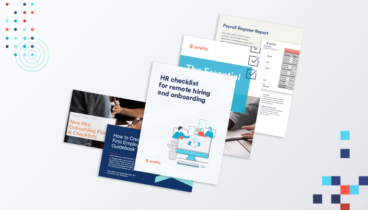The employee onboarding experience can make a deep impression on a new employee. Here are 9 ways to make the process more than something to survive.

When you add new team members, orienting them to your way of doing business is of the utmost importance. New hires can feel overwhelmed and unwelcome without proper support and inclusion during the initial adjustment period. Creating an efficient, effective onboarding experience for your company is essential.
A positive employee onboarding experience can improve employee retention and company morale. Employees who attend a structured orientation program are 69% more likely to remain at the company for at least 3 years, according to a CareerBuilder survey.
Here, you’ll find 9 of the best ways to create a successful onboarding experience and be sure to retain the top talent at your company.
1. Start before day one
Before your new hire starts their first day, you can make them feel included. Set them up with their company email and grant access to the company onboarding portal. That allows new hires to access content on their own time and get up to speed quickly.
Start the onboarding flow by connecting them to a welcoming video, a first-day schedule, and the ability to complete forms and HR documentation. If you send some company swag, make it personal with a welcoming note from their new coworkers.
2. Set clear goals
A positive onboarding program involves more than a warm welcome. Many organizations set expectations in the first week, if not the first day. They do this not to jolt recent hires into action, but because it helps them to achieve long-term success.
Set SMART goals for yourself and your team. These goals are specific, measurable, attainable, realistic, and timely. Create them with input from the executive team, managers, and team members. Before a new hire’s experience goes too deep, they need to know how their work will be judged and what success looks like in their new workplace culture. This is especially important for remote workers, who will have a harder time observing the working environment and organizational culture.
During employee onboarding, try to preempt some of their questions by asking yourself a few.
- Have all necessary company policies and procedures been clearly explained?
- Are all job expectations clearly in place and connected to concrete and measurable goals?
- Do your new hires understand the company culture and have the ability to establish and maintain positive relationships?
- How can you continue to support and maintain rapport with new hires over time?
3. Be inclusive
Studies indicate that diversity in the workplace fosters creativity, encouraging employees to be more diligent and work harder than they might in more homogenous workplaces. But an inclusive, diverse staff doesn’t just happen; you have to be intentional.
Including diversity, equity, and inclusion (DE&I) training in your onboarding process helps to demonstrate your company’s commitment to inclusion. This type of training can help make new hires feel valued for their unique qualities and confident that their contribution to company culture will be respected. Include meetings with all team leaders the employee will interact with regularly.
4. Diversify your media
Use multimedia tools to create a memorable onboarding experience. Don’t be satisfied with an employee experience that new hires simply survive. With software services like TriNet Zenefits, your onboarding process will center on people rather than bureaucracy. Many of your new hire’s first encounters and experiences will come from your formal onboarding program. Make sure they see that people, not process, is the focus.
Feel free to look beyond the digital. Make onboarding engaging and interesting by varying the presentation style beyond the typical PowerPoint. Think a scavenger hunt, icebreaker games, or competitions; anything to get people physically involved and their minds engaged.
5. Streamline
Most onboarding processes include a lot of administrative tasks, and paperwork. On average, the new hire completes more than 41 tasks during their onboarding period. Make this process as streamlined and easy to follow as possible, and your new hires will thank you.
6. Foster relationships
Making new team members feel included is an important way to boost employee engagement and employee productivity. Prepare the rest of the team for the new hire’s arrival before the first day. Make sure team members know if their duties and responsibilities are changing as a result of new jobs being filled.
Timing is key when introducing a new employee, so try to introduce them at a time when everyone is present and available to support their new colleague. Encourage a positive rapport and help new hires connect with people from across the company with scheduled lunches or meet and greets. If new remote employees can’t come into their workplace for initial meetings, set up virtual meetings and ice breakers.
7. Assign mentors
New hires want to feel connected not only to their team, but also to their leadership, and managers can play a key role in facilitating those relationships. A mentorship program may be a formal system, with goals and measures, or it can simply involve regular meetings between junior and senior staff in a more casual manner.
A mentor can be someone on the same team as your new hire, a team leader, a manager, an executive, or even the CEO, depending on the size of your company. The benefit of mentorship lies in intentionality. You want new employees to have a set time to ask questions in a more intimate setting. They can get a better feel for company culture, work-life balance and opportunities for growth in the organization.
8. Ongoing support
Oftentimes, once the structured onboarding process ends, employees feel a drop in support and may feel suddenly disconnected. This can be especially true for those operating remotely.
A strong onboarding process recognizes this and points the way to continued, helpful support available to all employees. This could look like open office hours where employees can come by to ask the manager questions, providing multiple channels to receive feedback, and long-term mentorship relationships.
9. System integration
Likewise, ensure that your onboarding system is integrated with your company’s HR platform. This makes a smooth transition from new hire to veteran employee without having to hassle with new passwords or learning yet another system. It also allows you to track your employee’s progress, as well as the effectiveness of your onboarding process.
The onboarding experience for remote employees
Today, many employees are hybrid or fully remote. Some companies run entirely on a remote basis. Even when your new hires may never set foot in an office, onboarding is still a crucial step, if not more so. Many of the tips for in-person onboarding still apply or can be easily tweaked for a virtual audience. Virtual platforms are a great way to provide cohesive onboarding programs from start to finish for remote employees. Relationship building looks different digitally than in person, but it certainly can be done. Virtual happy hours, Slack chats, and regular video-conference coffee meetings are great ways to bridge the digital divide.
Providing a comprehensive and cohesive onboarding experience is imperative to new employee retention, longevity with the company, and overall morale. For more information on innovative ways to engage new hires, check out this Workest article, Rethinking Onboarding from a People Ops Perspective.







